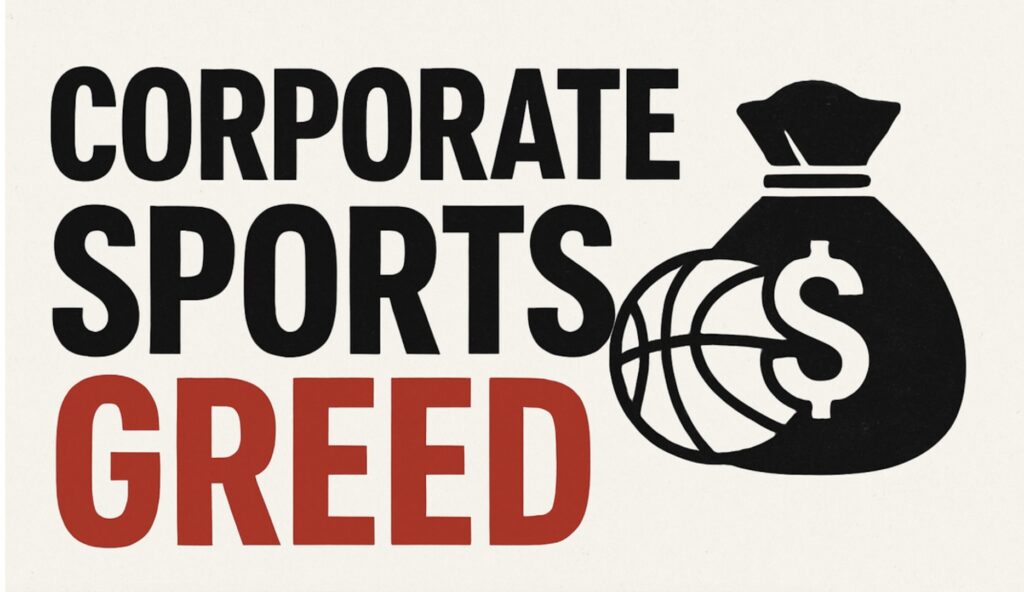
This article by Matt Alley first appeared on the BlueCollarWriter Labor Media site.
Once upon a time, the only thing standing between you and the roar of the crowd was a couch, a remote, and maybe a couple of rabbit ears on top of the TV. You didn’t need a spreadsheet to figure out how to watch your team. Sunday football was on broadcast television. Baseball was on the local channel all summer. Wrestling and boxing were on basic cable. You grew up with these games because they were there — and because they were for everyone.
Fast forward to now, and it feels like every sport has turned into a toll road. If you want to watch the NFL, you’re looking at YouTube TV’s base price around $83 a month, and if you want Sunday Ticket for the full slate, tack on another $479 for the season. Spread over four months, that’s about $240 a month just to be a complete NFL fan.
Basketball? Sure, NBA League Pass runs around $17 a month, but that doesn’t cover the big national games on ESPN, ABC, or TNT — for those, you need a live TV service like Hulu + Live TV or Sling, each pushing into the $70–$85 monthly range.
Baseball fans? MLB.TV is $30 a month — unless your favorite team is local, in which case you’re hit with blackout rules and have to pay extra for a regional sports network through yet another streaming or cable package. And for many teams offering their own direct-to-consumer feed, it’s still $20 a month or more just for one team.
UFC? Until 2026, you’ve got the ESPN+ subscription fee every month and $80 per pay-per-view event — and if you’re a diehard, that’s hundreds more per year on top of your base service.
WWE? Starting in 2026, it’ll be $29.99 a month just for Premium Live Events on ESPN’s new app, plus whatever you pay for USA Network to watch Raw, SmackDown, and NXT. That’s easily $70 a month combined.
And if you’re the type of fan who follows more than one sport — or worse, all of them — you’re looking at a tangled knot of subscriptions: Hulu + Live TV, Peacock, Paramount+, ESPN+, NBA League Pass, MLB.TV, WWE, and more. Add it up and you’re staring down $100–$200 every month just to keep up. That’s the cost of a decent used car payment — for the privilege of watching games that, just a generation ago, were practically free.
The Cord-Cutting Mirage
Cord-cutting was supposed to save us. We thought we’d escape the bloated cable bills and pay only for what we wanted. But the sports leagues saw an opening. Instead of one overpriced bill, we now have five or six — and they’re all overpriced. You have to cobble together two or three services just to follow a single team through a full season. Regional blackouts, exclusive streaming rights, and “premium” add-ons have replaced the simplicity we once had with a TV antenna.
The Cost of Losing Future Fans
This isn’t just about our wallets — it’s about the next generation. How does a kid fall in love with a sport they can’t watch? If Mom and Dad can’t justify $200 a month on streaming services, that kid grows up without the weekly ritual of game day. No lazy Sunday afternoons in front of the TV. No staying up past bedtime for an overtime playoff game. No shared family moments, no lifelong memories tied to the team.
When you price families out, you’re not just squeezing the present — you’re sacrificing the future. A generation that doesn’t grow up watching will never buy the jerseys, never plan trips to the stadium, never teach their kids the rules. The leagues may be counting record profits now, but they’re burning the seed corn.
The Greed Problem
Let’s be honest: this is greed, pure and simple. The leagues, the networks, and the streaming services have carved up the viewing rights like a roast, each taking a piece and charging a premium. They treat fandom like a luxury brand instead of a shared cultural experience. And while shareholders cheer, fans quietly walk away.
Sports aren’t just entertainment. They’re community. They’re identity. They’re part of our stories. But when they’re locked behind endless paywalls, those stories fade.
The warning signs are already here — cord-cutters who simply stop following certain leagues, kids who only see highlight clips on social media, fans who spend more time figuring out where a game is streaming than actually watching it.
At some point, the well runs dry. And when that happens, all the short-term profits in the world won’t buy back the lost generations.
Find Matt on Instagram at: https://www.instagram.com/bluecollarwriter

